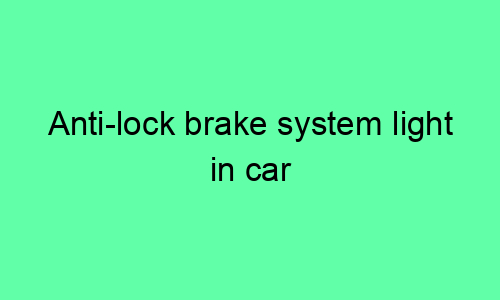- Anti-Lock Brake System (ABS) Light in Car: Causes and Solutions
- Causes of ABS Light
- Faulty Wheel Speed Sensor
- Malfunctioning ABS Control Module
- Air in the Brake Lines
- Faulty Brake Master Cylinder
- Low Brake Fluid Level
- Solutions for ABS Light
- Inspect the Wheel Speed Sensors
- Check the ABS Control Module
- Bleed the Brake Lines
- Replace the Brake Master Cylinder
- Top Up the Brake Fluid
- Conclusion
Anti-Lock Brake System (ABS) Light in Car: Causes and Solutions
The Anti-Lock Brake System (ABS) is a critical safety feature in modern cars. It helps prevent the wheels from locking up during braking, which can lead to loss of control and skidding. When the ABS light comes on, it indicates that there is a problem with the ABS system and it needs to be inspected and repaired as soon as possible.
Causes of ABS Light
Faulty Wheel Speed Sensor
Wheel speed sensors monitor the speed of each wheel and send the information to the ABS control module. If a wheel speed sensor fails, the ABS system may not be able to determine the speed of the wheel and may disable the ABS system as a precaution.
Malfunctioning ABS Control Module
The ABS control module is the brain of the ABS system. It receives signals from the wheel speed sensors and controls the ABS system’s operation. If the ABS control module fails, the ABS system will not work properly and the ABS light will come on.
Air in the Brake Lines
Air in the brake lines can cause the ABS system to malfunction. When air enters the brake lines, it can compress and cause the brake pedal to feel spongy and the ABS system may not work properly.
Faulty Brake Master Cylinder
The brake master cylinder pressurizes the brake fluid and sends it to the brake lines. If the brake master cylinder fails, it can cause the ABS system to malfunction and the ABS light will come on.
Low Brake Fluid Level
Low brake fluid level can cause the ABS system to malfunction. When the brake fluid level is low, it can cause air to enter the brake lines and the ABS system may not work properly.
Solutions for ABS Light
Inspect the Wheel Speed Sensors
Inspect the wheel speed sensors for any damage or corrosion. Clean the sensors and their connectors. If the sensors are damaged, they will need to be replaced.
Check the ABS Control Module
Check the ABS control module for any loose connections or corrosion. If the control module is faulty, it will need to be replaced.
Bleed the Brake Lines
Bleed the brake lines to remove any air. Use a brake fluid bleeder kit to bleed the brake lines and ensure that there is no air in the system.
Replace the Brake Master Cylinder
If the brake master cylinder is faulty, it will need to be replaced. This is a complex repair that should be performed by a qualified mechanic.
Top Up the Brake Fluid
Top up the brake fluid to the correct level. Use the recommended brake fluid for your car and ensure that the brake fluid reservoir is full.
Conclusion
Ignoring the ABS light can be dangerous and could lead to a loss of control of the vehicle. If the ABS light comes on, it is important to have the problem diagnosed and repaired as soon as possible. Regular maintenance can help prevent ABS problems and keep your car safe.






